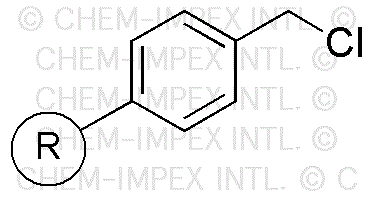Chloromethylated polystyrene is widely utilized in research focused on:
- Ion Exchange Resins: This compound is commonly used to create ion exchange resins, which are essential in water purification and chemical separation processes. Its ability to selectively bind ions makes it invaluable in industries such as pharmaceuticals and environmental science.
- Polymer Chemistry: Researchers leverage chloromethylated polystyrene as a building block for synthesizing various copolymers. This allows for the development of materials with tailored properties, enhancing applications in coatings and adhesives.
- Drug Delivery Systems: The compound plays a crucial role in the formulation of drug delivery systems. Its functional groups can be modified to improve the solubility and bioavailability of therapeutic agents, making it a key player in the pharmaceutical industry.
- Surface Modification: This chemical is used for surface modification of materials, enhancing adhesion and compatibility in composite materials. This application is particularly beneficial in the automotive and aerospace industries, where material performance is critical.
- Research and Development: In academic and industrial research, chloromethylated polystyrene serves as a versatile reagent for various chemical reactions, facilitating the development of new materials and processes that can lead to innovative solutions across multiple sectors.
General Information
Properties
Safety and Regulations
Applications
Chloromethylated polystyrene is widely utilized in research focused on:
- Ion Exchange Resins: This compound is commonly used to create ion exchange resins, which are essential in water purification and chemical separation processes. Its ability to selectively bind ions makes it invaluable in industries such as pharmaceuticals and environmental science.
- Polymer Chemistry: Researchers leverage chloromethylated polystyrene as a building block for synthesizing various copolymers. This allows for the development of materials with tailored properties, enhancing applications in coatings and adhesives.
- Drug Delivery Systems: The compound plays a crucial role in the formulation of drug delivery systems. Its functional groups can be modified to improve the solubility and bioavailability of therapeutic agents, making it a key player in the pharmaceutical industry.
- Surface Modification: This chemical is used for surface modification of materials, enhancing adhesion and compatibility in composite materials. This application is particularly beneficial in the automotive and aerospace industries, where material performance is critical.
- Research and Development: In academic and industrial research, chloromethylated polystyrene serves as a versatile reagent for various chemical reactions, facilitating the development of new materials and processes that can lead to innovative solutions across multiple sectors.
Documents
Safety Data Sheets (SDS)
The SDS provides comprehensive safety information on handling, storage, and disposal of the product.
Product Specification (PS)
The PS provides a comprehensive breakdown of the product’s properties, including chemical composition, physical state, purity, and storage requirements. It also details acceptable quality ranges and the product's intended applications.
Certificates of Analysis (COA)
Search for Certificates of Analysis (COA) by entering the products Lot Number. Lot and Batch Numbers can be found on a product’s label following the words ‘Lot’ or ‘Batch’.
*Catalog Number
*Lot Number
Certificates Of Origin (COO)
This COO confirms the country where the product was manufactured, and also details the materials and components used in it and whether it is derived from natural, synthetic, or other specific sources. This certificate may be required for customs, trade, and regulatory compliance.
*Catalog Number
*Lot Number
Safety Data Sheets (SDS)
The SDS provides comprehensive safety information on handling, storage, and disposal of the product.
DownloadProduct Specification (PS)
The PS provides a comprehensive breakdown of the product’s properties, including chemical composition, physical state, purity, and storage requirements. It also details acceptable quality ranges and the product's intended applications.
DownloadCertificates of Analysis (COA)
Search for Certificates of Analysis (COA) by entering the products Lot Number. Lot and Batch Numbers can be found on a product’s label following the words ‘Lot’ or ‘Batch’.
*Catalog Number
*Lot Number
Certificates Of Origin (COO)
This COO confirms the country where the product was manufactured, and also details the materials and components used in it and whether it is derived from natural, synthetic, or other specific sources. This certificate may be required for customs, trade, and regulatory compliance.


